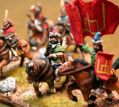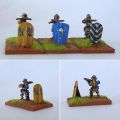Albanian
Historical Overview Section
1356-1430 and the Scanderberg Rebellion of 1443-78
Origins
During the late medieval period, a wide range of unappealing invaders ravaged the Albanian countryside and the Balkans. Norman, Italian Condotta Venetians, and Byzantine fleets attacked by sea. Early Bulgar, Early Serbian and all types of Byzantine forces came overland and held the region in their grip before swapping it amongst themselves for many years. But the Albanians were divided into various warring clans and were unable to oppose the invaders coherently. The Medieval era in Albania did see some semblance of order, and its roots lie in the way the territory was once one of the Thematic Byzantine Empire's Themes or military provinces. THe governmental groundwork laid down under Byzantine rule contributed to the eventual rise of feudalism in Albania, as peasant soldiers who served military lords became serfs on their landed estates. Among the leading families of the Albanian feudal nobility were the Thopia, Balsha, Shpata, Muzaka, Araniti, Dukagjini, and Kastrioti. The first three of these rose to become rulers of principalities that were practically independent of Byzantium. When in 1246 the Byzantine Empire smashed Bulgaria and pushed to the north Albanian coast, the feuding Albanian tribes began to coalesce and the Late Byzantines lost their tenure in the country in 1257 to Manfred, king of the Two Sicilies, and the state came almost into being when Charles I of Anjou, the ruler of the Kingdom of Naples and Sicily conquered much of central Albania; he called his new domain the Albanian kingdom. Internal power struggles further weakened the Byzantine Empire in the 14th century, and by this time the Later Serbian Empire had already established a dynasty to take control of northern Albania and when in the mid-1300s, Stefan Dušan, a Serbian king, conquered much of the western Balkans he took control over the newely coherent Albania (except the key city of Durres). Dusan drew up a legal code for his realm and crowned himself "Emperor of the Serbs, Greeks, Bulgarians, and Albanians" but in 1355, while leading an attack against Constantinople, Dušan suddenly died. His empire quickly broke apart, and his lands were divided among Serb and Albanian noblemen. Strong families came to the fore, especially the Balshas in the north and the Thopias in the center. Southern Albania fell to a Serbian chieftain, Thomas Preliubovich, in 1367 who was succeeded in 1385 by a Florentine (eh?) noble.
The Ottoman Conquest
Albanians had still not learnt their lessons by the time the Later Ottoman Turkish Sultan came a-knockin'. The many small, quarreling fiefdoms were easy pickin's for Ottoman armies. In 1385 a foolish Albanian ruler Karl Thopia appealed to the Sultan for support against his rivals and an Ottoman force quickly marched into Albania along the Via Egnatia and routed the Serbs in the Battle of Savra, however the end result was that the principal Albanian clans soon swore fealty to the Turks. Murad II then finished the job later on in 1423, and the Turks took pretty much all the good bits whilst allowing conquered Albanian clan chiefs to maintain their positions and property - although they had to pay tribute, send their sons to the Turkish court as hostages and provide the Ottoman army with auxiliary troops.
Skanderbergs Rebellion
The Albanians' resistance to the Turks in the mid-15th century won them acclaim all over Europe. It originated from the son of an Albanian clan leader sent as a hostage to Turkey was trained by the Turks and from them learnt how beat them! Renamed Iskander when he converted to Islam, he had participated in military expeditions to Asia Minor and Europe in the Sultans army, but when appointed to administer a Balkan district he became known as Skanderbeg and after Ottoman forces under Skanderbeg's command suffered defeat in a battle near Niš in 1443, the Albanian rushed to Krujë and tricked a Turkish pasha into surrendering him the fortress there. Skanderbeg then reembraced Roman Catholicism and declared a holy war against the Turks! On March 1, 1444 Albanian chieftains proclaimed Skanderbeg commander of the Albanian resistance and all of Albania accepted his leadership against the Ottoman Turks. Fighting under a really cool red flag bearing Skanderbeg's heraldic emblem, the Albanians (numbering around 30,000 men) then held off repeated brutal Ottoman campaigns for twenty-four years, and in 1449, the Albanians routed Murad II himself. The government under Skanderbeg was unstable, however, and at times local Albanian rulers cooperated with the Ottoman Turks against him (doh!). With support from the Kingdom of Naples and the Vatican resistance to the Ottoman Empire continued until the fall of the key city of Krujë in 1478; Shkodër succumbed in 1479 after a fifteen-month siege; and the Venetians evacuated Durrës in 1501. And that was that!
Using the army in FoG
- Looks tough. LH or Cv with Javelin & Lt Spear are cheap, mainly because they are not as good as other mounted troops - but its the mainstay of this army. However the Javelin. Lt Spear and Sword option means they are actually better than Bw/Sw types - if they can catch them without being shot up.
- The upshot is that you may again want an IC to provide an umbrella against shooting
- Your "best" knights are only average - yoiks! Think twice before selecting them.
UK Tournament Results with this army
Useful Links
User-contributed links about this army:
- Article on the Ottoman Conquest from some US academic site
- Albanians DBA Figure Gallery for this army - from Fanaticus
- Skanderberg on Wikipedia Loads more than you ever needed to know
- put the link text readers will see in here write some more detail about the link here
Allies
- Ottoman Turk, Later . Date restrictions: None Book: Eternal Empire Page: 8 - Bw/Sw Cavalry & LH in any combination of armour and quality you might wish for, plus some Balkan LH Lancers and a nice6-strong Janissary Bw unit. Better than what's in the main army anyway
- Internal Venetian or Neapolitan Ally - barely worth it for 4 Average KNights, but you take what crumbs of comfort you can from it I suppose.
15mm Manufacturers supplying figures for this army
Many manufacturers have generic Medieval and East European ranges - those noted have specific (or particularly good) relevant figres
You can see some of the figures in the Ancients Photo Gallery also on this site

|

|

|

|

|
- Essex Miniatures - Several East European Medieval ranges
- Donnington C15 Europe Range,
- Vexilia - v good East European ranges
- Museum Miniatures
- Gladiator Miniatures by Fighting 15's (Previously Black Hat) - East European range
- Old Glory 15's,
- fighting 15's - Uk supplier for Oddzial Ozmy's Polish-cast 1410 Tannenberg Teutonics, Polish & Lithuanians
- East Riding Miniatures For Wallachians they do a Vlad character figure in plate armor, on standing horse
- Isarus - sold by 15mm.co.uk E European Medieval range
- Viking Forge
- Irregular Miniatures 60 medievals in a range spanning East/West Europe from Late Feudal to C15
- Lancashire Games Around 30 generic & English medievals
- Tin Soldier 40 C14 & C15 medievals, including equipment
Core Troops
Which troops are absolutely needed for this army, and what are your thoughts on how to organise, paint and buy them.
Army Lists
Sample army lists for this army
Name of Army / Date
- Using asterisks inthe edit mode creates a bulleted list in the actual site
- This is a lot easier to do than easier than setting up tables
- For FoG I suggest listing your army in order or march
- with troop desctiptions on each line, for example
- 4 HF Armoured Average Drilled Impact Foot Swordsmen
- 8 LG Undrilled Unarmoured Poor Bowen
- Dont forget to include your Generals !!!
Include any notes you want here, including comments on how to use - or play against - the army.
Remember to leave a line before you copy the above section as a template for your own list
eBay Listings
UK Bookstore